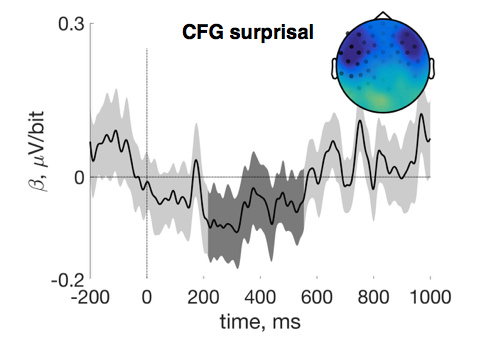Out today in PLoS ONE: John Hale and I test whether EEG correlates of syntactic expectation reflect syntactic structure or linear sequences while adults simply listen to a story. As in earlier work, we quantify expectations via surprisal and we compare models that differ in the context used to condition expectations. Effects around 200-400 ms after word onset correlate with surprisal based on hierarchical structure (a CFG based on the Berkeley parser), and this correlation holds when effects due to n-gram surprisal are partialed out using step-wise model comparison.
Brennan JR, Hale JT (2019) Hierarchical structure guides rapid linguistic predictions during naturalistic listening. PLoS ONE 14(1): e0207741. https://doi.org/10.1371/journal.pone.0207741
One thing that is especially exciting about this project is that we have released the data and stimuli. Use them, and let us know what you find!
Abstract below!
The grammar, or syntax, of human language is typically understood in terms of abstract hierarchical structures. However, theories of language processing that emphasize sequential information, not hierarchy, successfully model diverse phenomena. Recent work probing brain signals has shown mixed evidence for hierarchical information in some tasks. We ask whether sequential or hierarchical information guides the expectations that a human listener forms about a word’s part-of-speech when simply listening to every-day language. We compare the predictions of three computational models against electroencephalography signals recorded from human participants who listen passively to an audiobook story. We find that predictions based on hierarchical structure correlate with the human brain response above-and-beyond predictions based only on sequential information. This establishes a link between hierarchical linguistic structure and neural signals that generalizes across the range of syntactic structures found in every-day language.

